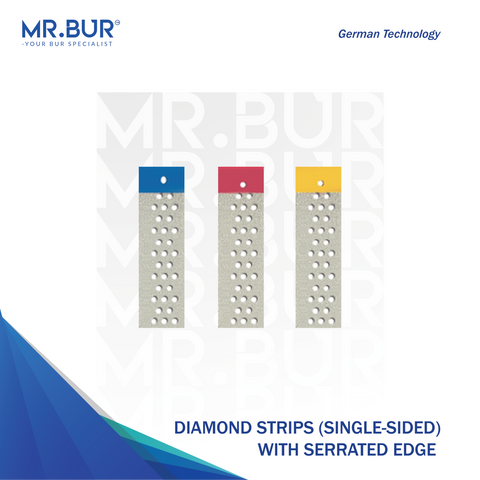Diamond Strips
Diamond Strips are essential for precise interproximal finishing and contouring in restorative dentistry. Coated with fine diamond particles, these strips ensure smooth polishing, accurate contact adjustments, and seamless restoration refinement. Perfect for veneers, crowns, and composites, diamond strips offer unmatched control and efficiency, making them a trusted choice for dental professionals.




More about Diamond Strips
Diamond strips are essential tools in dental procedures, particularly for interproximal reduction, shaping, and contouring.
1. Innovations in Diamond Strip Design for Enhanced Debris Removal
Modern diamond strips feature perforated designs that assist in debris removal during interproximal reduction. This innovation improves visibility, control, and flexibility, leading to more efficient procedures.
2. Color-Coded Grit Selection: Simplifying Dental Procedures
Diamond strips are often color-coded to indicate different grit levels—blue for medium, red for fine, and yellow for super-fine. This system simplifies the selection process for dental professionals, ensuring appropriate abrasiveness for each specific task.
3. The Role of Diamond-Free Zones in Interproximal Strips
Incorporating diamond-free zones in strips facilitates easier insertion between teeth and precise preparation, enhancing the efficiency of interproximal procedures.
4. Autoclavable Diamond Strips: Ensuring Sterility and Reusability
Stainless steel diamond strips that are resistant to breaking and stretching can be autoclaved, offering reusability and maintaining sterility in dental practices.
5. Perforated vs. Non-Perforated Diamond Strips: A Comparative Analysis
Perforated diamond strips assist in debris removal and provide improved visibility, control, and flexibility compared to non-perforated strips, enhancing the overall efficiency of dental procedures.
6. Applications of Diamond Strips in Orthodontic Interproximal Reduction
Diamond strips are utilized in orthodontics for interproximal reduction, aiding in the correction of crowding and reshaping contact areas between teeth.
7. Advancements in Diamond Strip Materials: Enhancing Durability and Performance
The use of high-quality stainless steel in diamond strips increases resistance to breaking and stretching, thereby enhancing durability and performance during dental procedures.
8. The Importance of Grit Selection in Achieving Optimal Finishing Results
Selecting the appropriate grit—coarse, fine, or super-fine—is crucial for achieving desired finishing results in dental restorations, impacting the smoothness and quality of the final outcome.
9. Ergonomic Design Features in Modern Diamond Strips
Modern diamond strips are designed with ergonomic features that provide control and flexibility, reducing hand fatigue and improving precision during dental procedures.
10. The Role of Diamond Strips in Minimally Invasive Dentistry
Diamond strips enable precise enamel reduction and contouring, supporting minimally invasive dentistry practices by preserving more natural tooth structure.
11. What are diamond strips used for in dentistry?
Diamond strips are primarily used for interproximal reduction (IPR), contouring, and finishing in dental procedures. They help in precise enamel reduction between teeth, facilitating orthodontic treatments, restorative procedures, and the finishing of composite restorations.
12. How do single-sided and double-sided diamond strips differ?
Single-sided diamond strips have abrasive material on one side, allowing for selective enamel reduction without affecting adjacent teeth. Double-sided strips have abrasives on both sides, enabling more comprehensive reduction. The choice between them depends on the specific clinical requirements.
13. What is the significance of perforated diamond strips?
Perforated diamond strips feature a design that assists in debris removal during procedures, providing improved visibility, control, and flexibility. This design enhances the efficiency of interproximal reduction, shaping, and contouring.
14. How does grit size affect the use of diamond strips?
Grit size determines the abrasiveness of the diamond strip. Coarse grits are used for significant enamel reduction, medium grits for shaping, and fine or superfine grits for finishing and polishing. Selecting the appropriate grit size is crucial for achieving the desired outcome in dental restorations.
15. Are diamond strips reusable?
Many diamond strips are made of stainless steel and are autoclavable, allowing for reusability while maintaining sterility in dental practices. However, the lifespan of a diamond strip depends on the quality of the material and the frequency of use.
16. What role do diamond strips play in supportive periodontal therapy (SPT)?
In supportive periodontal therapy, diamond strips are used for precise enamel reduction and interproximal contouring, aiding in the maintenance of periodontal health by facilitating better plaque control and preventing disease progression.
17. How do diamond strips contribute to minimally invasive dentistry?
Diamond strips enable precise enamel reduction and contouring, supporting minimally invasive dentistry practices by preserving more natural tooth structure. This approach enhances patient comfort and outcomes.
18. What are the ergonomic design features of modern diamond strips?
Modern diamond strips are designed with ergonomic features that provide control and flexibility, reducing hand fatigue and improving precision during dental procedures. Features such as handles or specific strip lengths contribute to ease of use.
19. How do diamond-free zones in strips enhance their functionality?
Incorporating diamond-free zones in strips facilitates easier insertion between teeth and precise preparation, enhancing the efficiency of interproximal procedures by preventing unintended enamel removal.
20. What advancements have been made in diamond strip materials?
Advancements include the use of high-quality stainless steel and natural diamond abrasives, increasing resistance to breaking and stretching, thereby enhancing durability and performance during dental procedures.
